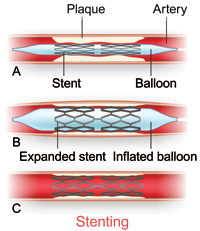 Our 43rd president, George W. Bush, recently was
diagnosed with a blockage of one of the arteries of his heart. It required a
cardiac procedure called stent implantation. Many people are now interested
in knowing more about the procedure and why it was needed. Here are some coronary stent basics.
Our 43rd president, George W. Bush, recently was
diagnosed with a blockage of one of the arteries of his heart. It required a
cardiac procedure called stent implantation. Many people are now interested
in knowing more about the procedure and why it was needed. Here are some coronary stent basics.
What is a stent and what is its
function?
A
stent is a small mesh tube made of
either stainless steel or cobalt chromium alloys that is placed by a catheter
into a narrowed (blocked) coronary artery. The stent helps enlarge a segment of
the artery to improve blood flow, which should reduce or eliminate symptoms of
chest pain. Stent technology is continually developing so we now use stents
coated with medication which helps prevent the stent from clogging and narrowing
(a process called restenosis).
Who needs a stent?
Stents
are used to reduce symptoms in patients with obstructive artery disease who suffer
chest pain/tightness or shortness of breath that might be experienced with
exercise or during periods of strong emotions. Stents may be used instead of
bypass surgery in some selected patients. Diabetic patients with multiple
coronary blockages may do better with bypass surgery.
What is the stenting procedure?  Stents
are placed during a coronary angiogram. A small tube called a balloon catheter
is inserted into the femoral artery (leg) or the radial artery (arm), and
advanced toward the heart to the very top of the aorta. After the blockage is identified,
a wire is placed into the coronary artery to the site of the blockage and the
stent is loaded on to the wire. The stent is expanded to the size of the artery
and may be expanded by inflating a balloon within the stent. Then the wires are
removed along with the catheter, while the stent stays in the artery permanently.
Stents
are placed during a coronary angiogram. A small tube called a balloon catheter
is inserted into the femoral artery (leg) or the radial artery (arm), and
advanced toward the heart to the very top of the aorta. After the blockage is identified,
a wire is placed into the coronary artery to the site of the blockage and the
stent is loaded on to the wire. The stent is expanded to the size of the artery
and may be expanded by inflating a balloon within the stent. Then the wires are
removed along with the catheter, while the stent stays in the artery permanently.
What happens after the procedure?
Recovery
from an angioplasty and stent implantation is usually fast. Most patients can resume
normal activities 24 hours after the procedure. Some people experience bruising,
which will disappear in a few days.
Due
to a heightened risk of clotting after stenting, treatment with Aspirin AND
antiplatelet drugs (also called anti-clotting drugs) is required for at least
one year. Among the possible antiplatelet drugs your cardiologist may prescribe
are clopidogrel (Plavix) or ticagrelor (Brilinta). Make sure you understand the
dosage and duration of the medications as detailed by your doctor. Do not
stop these medications without consulting your cardiologist.
Does a stent cure coronary artery disease?
Stents
help prevent arteries from becoming narrow or blocked again in the months or
years after the procedure. However, they are NOT a cure for coronary artery
disease and they DON'T reduce your risk factors.
Talk
with your cardiologist so you have a clear understanding of the risks and
benefits of stent implantation. Keep close control of your risk factors
for coronary heart disease including hypertension, high bad cholesterol (LDL),
and smoking.
Lifestyle changes based on a healthy diet, not smoking and being
physically active can go a long way to help prevent plaque from building up in
your arteries again.
Until next time!

Stephanie Coulter, MD
P.S.
Read the Heart Information Center article: Balloon Angioplasty and Stents.
And for more on this topic straight from the news ...
- Listen to Dr.
James T. Willerson, THI president, explain stenting in this 3-minute interview with National Public Radio.
- Read this article from the Houston Chronicle about the
latest in stent technology.
Do you have a topic that you would like to learn more about from Dr. Stephanie? Send us an email at women@texasheart.org and your question may be the next Straight Talk topic!
We are saving hearts and trees. The
Women's Heart Health E-News is sent via e-mail and posted online. Sign up using the form on this page.
Visit the Center for Women's Heart & Vascular Health at www.texasheart.org/women.

